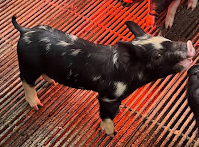Berkshire Breed Eligibility
To maintain the integrity of the Berkshire breed, there are specific standards set. If you have any questions, please contact the ABA office.
Scroll to the bottom for examples.
ABA Constitution and By-Laws: Berkshire Markings and Identification Requirements
ARTICLE XIX - Markings and Identification Requirements
Section 1. Color. The ideal color pattern is black with six white points (face, four socks, tip of tail). Less desirable, but acceptable, are sandy colored hair in the areas where white and black border. Color Qualifications for Registration (boars, gilts and barrows must meet the following color requirements in order to be recorded): A Berkshire must have white on the face and tail, unless the tail is docked. Three of four legs must be white. A Berkshire must not have a spotted or mottling pattern, which is defined as an intermixture of black and white and/or red skin/hair anywhere on the pig’s body (defined as anything above the elbow and flank and excludes the legs and under belly). Examples of spotted or mottling patterns include: cheetah and giraffe spotted markings anywhere on the back or side of the pig. Also, a Berkshire must not have a contiguous area of white and/or red skin/hair that exceeds 64 square inches anywhere on the body (defined as anything above the elbow and flank and excludes the legs and under belly) of a mature pig (approximately 8 x 8 square inch area on a 300 lb pig; this would be equivalent to 11 square inches on a 50 lb pig). Finally, a Berkshire cannot have a full or 3⁄4 belting pattern that is defined as white skin or hair that fully encircles or nearly encircles the body anywhere between the base of the ear and base of the tail.
Section 2. Ear Carriage. The ideal ear carriage is ridged and tight. Less desirable, but acceptable, ear carriage is: a) ears that are larger than astatically pleasing and b) ear carriage that lacks rigidity.
Section 3. Identification Requirements. No animal shall be eligible to record unless it is distinctively ear-notched at farrowing time. All pigs from the same litter must carry the same litter notch. When individual ear-notches are used, the right ear shall be used for the litter notch and the left ear for individual notch, in accordance with the official Berkshire ear-notching system. Official ear-notching system available on request. No two litters on the farm shall be ear-notched the same during the same farrowing season, which may be interpreted as being between January 1 through June 30 and July 1 through December 31 of each year.
Section 4. Disqualification for Registration of Breeding animals. The presence of one or more of the following are disqualifications for registration: a) less than 6 functional teats on each side, b) the presence of one or more swirls on upper half of the body, c) total blindness, d) rectal or uterine prolapse, e) hermaphroditism, f) atresia ani; g) cryptorchidism or monorchidism; h) scrotal and/or umbilical hernia, and i) ear carriage that “breaks” to the point in which ears are continually directed in a downward angle.
Ineligible Berkshire Characteristic Examples
EXCESSIVE WHITE
A Berkshire must not have a contiguous area of white and/or red skin/hair that exceeds 64 square inches anywhere on the body (defined as anything above the elbow and flank and excludes the legs and under belly) of a mature pig (approximately 8 x 8 square inch area on a 300 lb pig; this would be equivalent to 11 square inches on a 50 lb pig).
EAR CARRIAGE
The ideal ear carriage is ridged and tight. Less desirable, but acceptable, ear carriage is: a) ears that are larger than astatically pleasing and b) ear carriage that lacks rigidity.
SPOTTING OR MOTTLING
A Berkshire must not have a spotted or mottling pattern, which is defined as an intermixture of black and white and/or red skin/hair anywhere on the pig’s body (defined as anything above the elbow and flank and excludes the legs and under belly). Examples of spotted or mottling patterns include: cheetah and giraffe spotted markings anywhere on the back or side of the pig.
BELT
A Berkshire cannot have a full or 3⁄4 belting pattern that is defined as white skin or hair that fully encircles or nearly encircles the body anywhere between the base of the ear and base of the tail.













